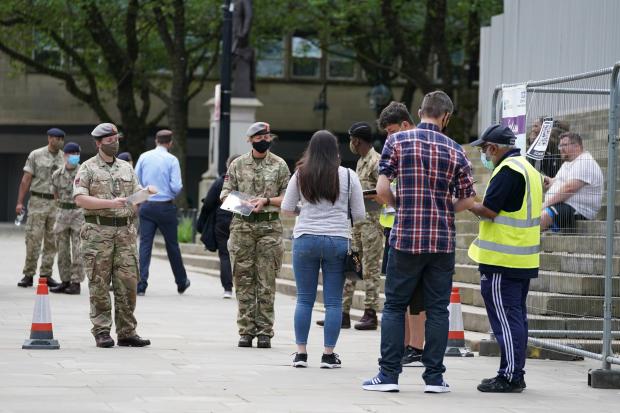Bolton coronavirus infection rate higher now than during May peak
The current coronavirus infection rate in Bolton is now far higher than the May peak of the pandemic Ââ€" when the Delta variant rapidly spread a across the town.
At that time Bolton was recording by far the highest infection rate in the country due to the increasing prevalence of this variant.
This resulted in a huge response for local public health teams, NHS, and CCG, who encouraged everyone to get a Covid test, whether they had symptoms or not, and surge vaccinations where as many people as possible were urged to get the jab at local sites.
 Testing at ESSA Academy
Testing at ESSA Academy
In the seven days to July 18, Bolton recorded 1,468 new cases of Covid-19, equalling an infection rate of 510.5 new positive cases per 100,000 residents.
This is a significant increase from the previous seven days, to July 11, where an infection rate of 335.2 per 100,000 was recorded.
The infection rate now is much higher than it was when compared to when the Delta variant was first causing problems in the borough.
 Testing at ESSA Academy in May
Testing at ESSA Academy in May
The peak of this wave came in the seven days to May 21 where the town recorded a rate as high as 452 cases per 100,000 residents, before the rate started to drop again as surge testing and vaccinations had a positive impact.
At that time, Bolton was recording by far the highest rate in the country, however, this is no longer the case.
Bolton is recording the lowest rate of infections in Greater Manchester, with towns in the north east recording the most cases in the country.
 Testing outside the town hall
Testing outside the town hall
This all comes as record numbers of people are being told to self isolate by the NHS Covid-19 app during what some are calling a 'pingdemic'.
Department for Health and Social Care data shows 2,312 people were told to self-isolate after being in contact with someone who tested positive for Covid-19 in Bolton for the week to July 14 â€" the latest available data.
This was up from 1,770 the week before, and means 3,894 people have been told to isolate in the latest 14 days alone.
Greater Manchester infection rates
From left to right: name of local authority; rate of new cases in the seven days to July 18; number (in brackets) of new cases recorded in the seven days to July 18; rate of new cases in the seven days to July 11; number (in brackets) of new cases recorded in the seven days to July 11.
Wigan, 825.8, (2714), 559.2, (1838)
Oldham, 812.7, (1927), 645.3, (1530)
Tameside, 695.8, (1576), 473.7, (1073)
Salford, 693.9, (1796), 560.2, (1450)
Rochdale, 682.5, (1518), 633.1, (1408)
Bury, 606.8, (1159), 417.3, (797)
Stockport, 604.6, (1774), 434.5, (1275)
Manchester, 581.2, (3213), 502.3, (2777)
Trafford, 543.1, (1289), 527.9, (1253)
Bolton, 510.5, (1468), 335.2, (964)
0 Response to "Bolton coronavirus infection rate higher now than during May peak"
Post a Comment